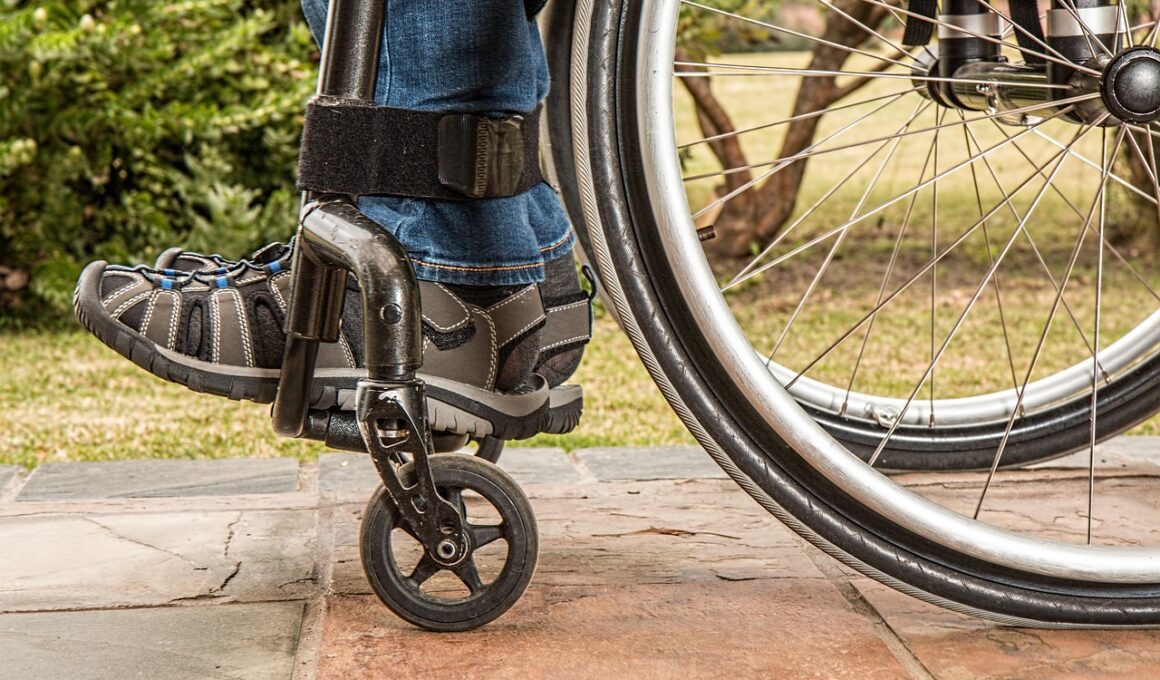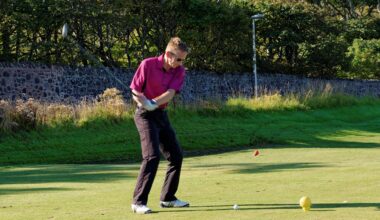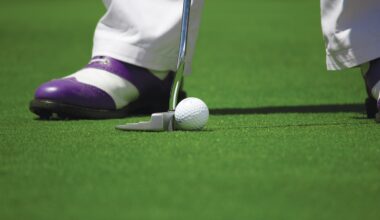Using Calisthenics to Improve Functional Movement Post-Injury
Calisthenics offers an effective approach for rehabilitation, focusing on bodyweight exercises that enhance strength, flexibility, and balance. When recovering from an injury, it is crucial to regain functional movement to restore daily activities effectively. This method emphasizes controlled movements, which promote muscle engagement without stressing the joints excessively. Start with fundamental movements such as squats and push-ups, adjusting difficulty based on individual capabilities. Gradually increase the intensity and complexity of exercises as functional movement improves. By integrating calisthenics into rehabilitation, patients experience accessible and adaptable workouts that empower them throughout the healing process. Moreover, incorporating variations such as isometric holds and dynamic movements can provide additional strength benefits while keeping the regimen versatile and engaging. This approach allows individuals to connect to their bodies and understand their limits. Furthermore, the adaptability of calisthenics makes it suitable for diverse injuries and physical conditions. Working with skilled professionals ensures personalized modifications tailored to each patient, enhancing recovery outcomes significantly. In summary, calisthenics effectively aids rehabilitation via systematic movement patterns, ensuring patients develop functional strength essential for independent living.
A strong foundation in basic movements is essential for rehabilitation. By focusing on exercises that emphasize proper form and controlled execution, patients can strengthen weak areas and enhance overall stability. To establish a robust foundation, here are several key exercises to include in a calisthenics program:
- Bodyweight squats: Strengthen the legs and improve hip mobility.
- Push-ups: Develop upper body strength and core stability.
- Planks: Focus on core engagement and endurance.
- Lunges: Enhance balance, coordination, and leg strength.
These exercises not only target vital muscle groups but also promote good posture and alignment, crucial during recovery. Gradually enhancing the volume and complexity of these movements lays the groundwork for more advanced calisthenic exercises later. Consistent practice is key; as strength builds, patients can challenge themselves with variations that focus on single-leg or elevated techniques. This incremental approach allows patients to observe measurable progress while minimizing the risk of re-injury. Physiotherapists often recommend exercising on various surfaces like stability balls or balance boards to enhance engagement further.
Incorporating mobility and flexibility exercises is crucial in ensuring a successful recovery process. As muscles become stronger, promoting joint and tissue flexibility reduces the risk of injury recurrence. Additionally, a focus on flexibility increases the range of motion, allowing for more effective movements in daily activities. Techniques such as dynamic stretching encourage increased blood flow and prepare the body for exercise, while static stretching aids in post-workout recovery. To maximize flexibility through calisthenics, consider implementing the following methods:
- Yoga-inspired movements: Enhance flexibility while promoting breathing techniques.
- Controlled leg swings: Create mobility throughout the hips and legs.
- Arm circles: Improve upper body range of motion.
Focus on performing these stretches within a calisthenics routine several times per week to promote overall joint health and improve recovery time. Regular practice should lead to significant advancements in functional capabilities, thus empowering individuals to return to their regular activities sooner. Moreover, flexibility training can contribute positively to emotional well-being, relieving stress and tension.
Listening to Your Body
A crucial element during rehabilitation is listening to your body and recognizing its signals. Recovery from injury varies from person to person, and customizing calisthenics exercises to fit personal comfort levels is vital. Paying attention to pain and discomfort helps prevent setbacks and allows for better alignment of exercises to individual needs. Practicing mindfulness techniques can improve self-awareness during workouts and enhance the overall recovery experience. As patients engage in calisthenics, learning how to differentiate between effective muscle engagement and concerning pain is crucial. Utilizing a **pain scale** approach encourages individuals to rate their discomfort, adjusting exercises accordingly, and ensuring a progressive recovery path. It’s fundamental to communicate openly with a healthcare professional or physiotherapist, discussing any challenges encountered during practice. Together, they can develop a suitable exercise plan based on progress, addressing weaknesses, and monitoring effectiveness. Prioritizing rest is equally important so that the body can adequately heal and rebuild. To maintain motivation, set short-term and long-term goals that encourage personal growth. This positive mindset aids in consistency and bolsters the desire for daily practice.
Incorporating different types of resistance training while practicing calisthenics enhances strength and resilience. Resistance bands, for instance, can be valuable tools for rehabilitating individuals, providing a unique form of assistance and resistance. They facilitate improved control during exercises, ensuring proper form, especially for those recovering from injury. Here are some essential ways to utilize resistance bands in calisthenics routines:
- Assisted Pull-Up: Bands provide support to facilitate effective execution.
- Squats with Resistance: Increases leg engagement and build endurance.
- Chest Press: Builds upper body strength while minimizing joint stress.
Gradually increasing the resistance level allows individuals to track progress and adapt their routines accordingly, continually challenging their muscles. As strength improves, individuals can transition to bodyweight-only exercises, reflecting enhanced capabilities. The versatility of resistance bands makes them adaptable to various injuries, ensuring a gradual and safe increase in difficulty. Meanwhile, individuals can enjoy flexibility in their workouts, keeping sessions dynamic and engaging. Additionally, using resistance bands fosters confidence as patients witness their strength gain and functional movement improvement firsthand.
Strengthening Core Stability
Core stability plays a significant role in recovery and rehabilitation. A strong core supports other body movements, reduces the risk of injury, and promotes proper posture. Engaging the core during calisthenics workouts amplifies their effectiveness, ensuring focused training on essential stability muscles. Incorporate exercises such as hollow body holds, bird-dogs, and dead bugs, all targeting core activation while complimenting calisthenics principles. Include these movements within standard routines to foster essential muscular coordination and balance. Furthermore, developing core stability improves functional strength necessary for daily activities, leading to better ease of movement. By enhancing strength and stability, individuals build a more resilient body capable of withstanding various strains faced during their recovery journey. Additionally, attention to breathing techniques while working on the core helps optimize performance and overall fitness development. Practicing deep abdominal breathing techniques during calisthenics encourages a deeper connection between mind and body, contributing positively to mental health as well. Integrating core stability exercises into daily routines can improve overall workout efficiency, maximizing the benefits of rehabilitation with calisthenics.
Lastly, establishing a supportive environment greatly boosts recovery during rehabilitation. Building a network of family, friends, and healthcare professionals encourages accountability and fosters motivation throughout the recovery process. Share progress milestones with loved ones; this creates a sense of accomplishment, thereby enhancing emotional well-being. Consider joining local calisthenics classes or online communities focused on rehabilitation, providing opportunities to interact with others on a similar journey. Sharing experiences can offer encouragement and practical tips for overcoming challenges encountered while healing. Encouraging personal achievements, no matter how small, contributes to a positive mindset, emphasizing growth and determination. Moreover, surrounding oneself with a supportive community helps identify any potential setbacks or risks that may arise during the rehabilitation process. Engaging regularly with the community fosters a belongingness that can significantly enhance motivation levels for maintaining consistency. Ultimately, the journey towards improvement requires not only physical efforts but emotional and mental support as well. Cultivating a positive environment infused with encouragement can instigate lasting commitments to adopting calisthenics as a long-term approach for improved health and functional movement.
This article emphasizes the power of calisthenics in improving functional movement post-injury. Utilizing bodyweight exercises, focusing on gradual progression, and incorporating mobility and flexibility techniques are pivotal components in rehabilitation. Through establishing a supportive environment, listening to one’s body, and emphasizing core stability, individuals can maximize recovery potential and enjoy lasting benefits. Calisthenics presents a versatile option adaptable to varying injury types and fitness levels. The patient-centric approach allows for exercising at one’s own pace while progressively regaining strength, stability, and mobility. The healing journey can be transformative, fostering newfound confidence and physical prowess. Embrace calisthenics as a pivotal aspect of recovery and well-being, advocating a balanced approach that prioritizes self-care along the path to recovery. By working collaboratively with professionals and engaging in a positive practice environment, individuals can look forward to a more robust and functional future. Rehabilitation through calisthenics not only restores physical capabilities but enhances overall mental resilience. This dual benefit maximizes well-being, encouraging individuals to thrive in their post-recovery lives. Calisthenics is more than just a training method; it serves as a pathway to holistic health and revitalization.


